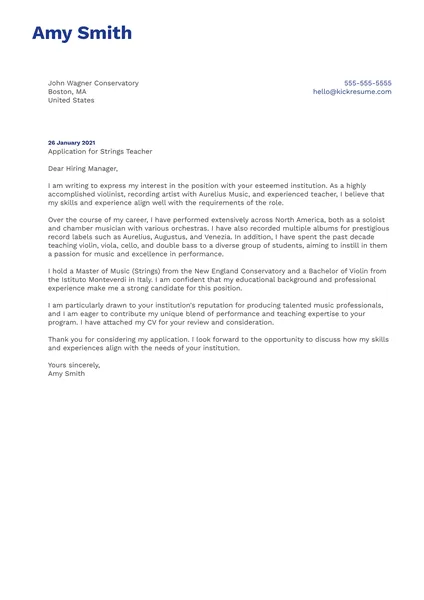Understanding the Teacher Aide Role
Before you start writing your cover letter, it’s crucial to understand what a Teacher Aide does. A Teacher Aide, also known as a Teaching Assistant, plays a vital role in supporting the teacher and assisting students in the classroom. They help with various tasks, including preparing learning materials, supervising students during activities, providing one-on-one or small group support, and managing classroom behavior. A solid understanding of these responsibilities will help you tailor your cover letter to highlight the most relevant skills and experiences, demonstrating that you’re a suitable candidate for the role. It’s also important to research the specific requirements of the job you’re applying for, as responsibilities can vary depending on the school, grade level, and the teacher’s needs.
Essential Skills for Teacher Aides
Teacher Aides require a diverse set of skills to excel in their roles. These include strong communication and interpersonal skills, patience, empathy, and the ability to work effectively with children of all ages and backgrounds. Organization and time management are also crucial, as Teacher Aides often juggle multiple tasks simultaneously. Furthermore, a good understanding of child development and learning theories can be advantageous. Any experience with classroom management techniques, such as positive reinforcement or behavior modification strategies, can be highly valuable. Highlight these skills in your cover letter by providing specific examples of how you’ve utilized them in previous roles or situations. The ability to adapt to different learning styles and create a supportive learning environment is also key.
Writing a Powerful Cover Letter
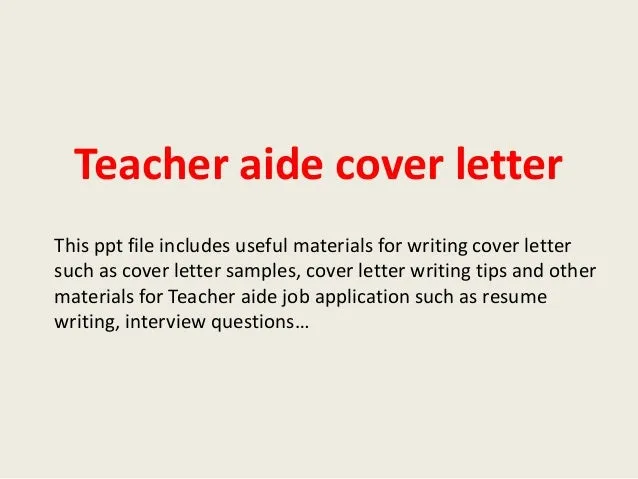
Your cover letter is your opportunity to make a strong first impression and showcase why you are the best candidate for the Teacher Aide position. It should be well-written, concise, and tailored to the specific job and school. A generic cover letter won’t cut it; you need to personalize it to demonstrate your genuine interest and enthusiasm. The best cover letters are clear, direct, and free of errors. They should also highlight your most relevant skills and experiences. Your cover letter should complement your resume, expanding on your achievements and providing context for your qualifications. Think of it as a narrative, telling the story of your suitability for the role, and how your skills and experiences align with the needs of the school and the teacher you would be assisting.
Header and Contact Information
Begin your cover letter with a professional header that includes your full name, address, phone number, and email address. Ensure that your email address is professional and appropriate. It’s also customary to include the date, the name of the hiring manager (if known), their title, and the school’s address. If you can’t find the hiring manager’s name, address your letter to the hiring committee or the principal. Accuracy is paramount; double-check all contact information to avoid any missed opportunities. This section sets the tone of professionalism and provides the employer with the necessary details to contact you. Use a clear and easy-to-read font, such as Times New Roman or Arial, and maintain consistent formatting throughout your letter.
Greeting and Introduction
Start your cover letter with a formal greeting, such as “Dear Mr./Ms. [Last Name]” or “Dear Hiring Committee.” In the opening paragraph, state the position you are applying for and how you learned about the opportunity. Briefly introduce yourself and highlight your most relevant qualifications or experiences. This is your chance to grab the reader’s attention and make them want to learn more. Express your enthusiasm for the role and the school. Briefly mention any personal connection you have with the school or its mission. Your introduction should be concise and compelling, setting the stage for the rest of your letter and making it clear why you’re a strong candidate.
Highlighting Relevant Experience
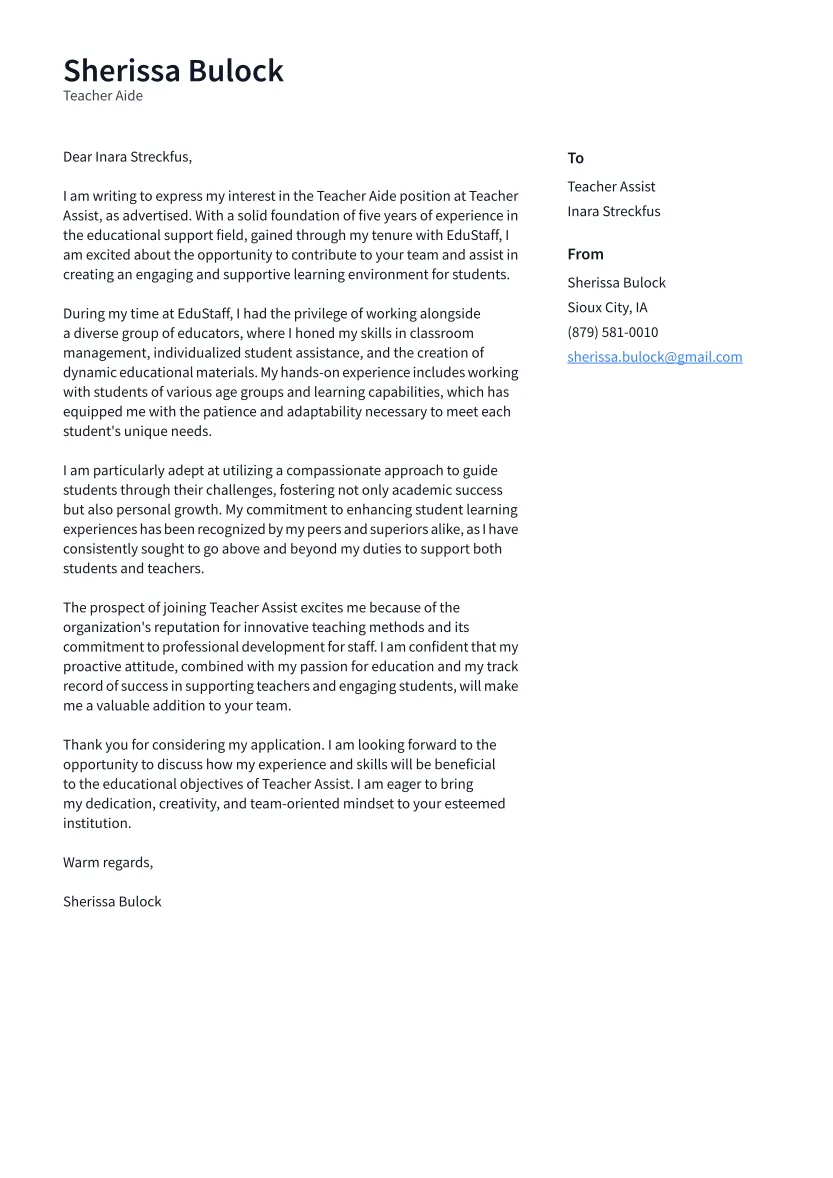
The body of your cover letter should focus on showcasing your relevant experience. Use specific examples to illustrate your skills and accomplishments. Instead of simply listing your responsibilities, describe how you applied your skills in previous roles, the actions you took, and the positive outcomes. For instance, if you have experience assisting students with special needs, describe the strategies you used to support them and the impact you had on their learning. If you have experience managing classroom activities, describe your approach to organization and maintaining a positive learning environment. Quantify your accomplishments whenever possible, such as the number of students you supported or the improvement in student performance. Tailor this section to the specific requirements of the job description.
Showcasing Key Skills and Abilities
In addition to your experience, emphasize the key skills and abilities that make you a great Teacher Aide. Consider the skills we mentioned earlier such as communication, patience, organization, and a strong understanding of child development. Provide specific examples of how you have demonstrated these skills in the past. For instance, describe how you used your communication skills to explain concepts to students or how you used your organizational skills to prepare learning materials. Showcase your ability to work collaboratively with teachers, parents, and other staff members. Demonstrate your ability to adapt to different learning styles and to create a supportive and inclusive learning environment for all students. Remember to align your skills with the needs of the school and the specific requirements of the job description.
Emphasizing Passion and Enthusiasm
Let your passion and enthusiasm for working with children and supporting education shine through your cover letter. Explain why you are drawn to the role of a Teacher Aide and what motivates you to work with children. Share your commitment to creating a positive and engaging learning environment. Describe your understanding of the importance of education and your desire to make a difference in the lives of students. Explain why you’re interested in working at that specific school or in that particular educational setting. Your passion will make you stand out from other candidates, and demonstrate your genuine commitment to the role. Avoid clichés and strive to be authentic in your expression of enthusiasm.
Tailoring to the Specific Job
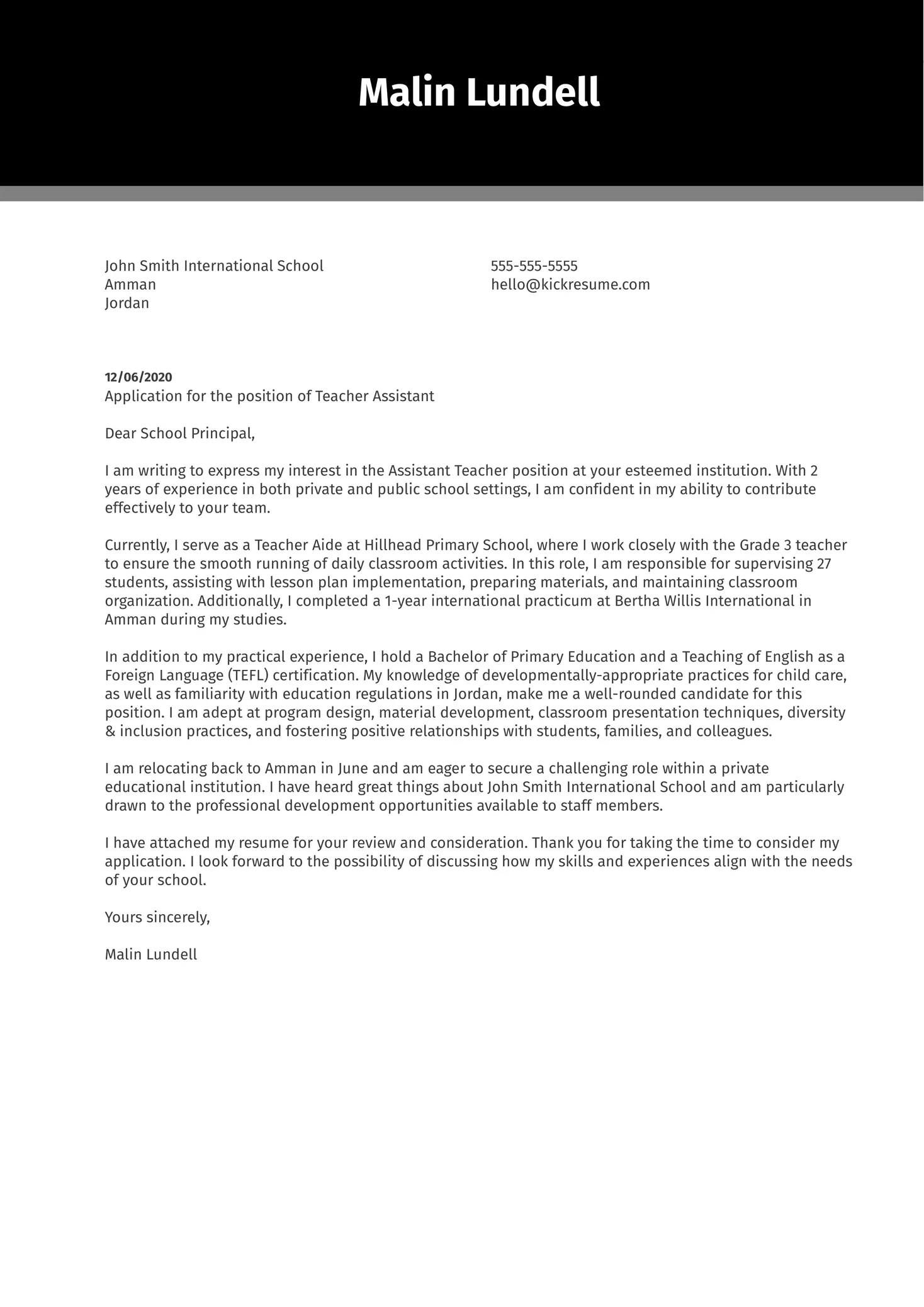
Every Teacher Aide position is unique, so it’s essential to tailor your cover letter to each job you apply for. Carefully read the job description and identify the key skills, experiences, and qualifications that the school is seeking. Then, customize your cover letter to address those specific requirements. Highlight the relevant experience and skills that align with the job description. Show the employer how your qualifications make you a good fit for their specific needs. The more tailored your letter is, the better your chances of getting an interview. This shows the hiring manager that you’ve taken the time to understand the role and the school’s values, which will make you a more appealing candidate.
Call to Action and Closing
In your closing paragraph, reiterate your interest in the position and thank the hiring manager for their time and consideration. Include a call to action, such as expressing your availability for an interview and providing your contact information again. Be confident and enthusiastic, and reiterate your eagerness to learn more about the opportunity. End with a professional closing, such as “Sincerely” or “Best regards,” followed by your full name. Make sure you address the letter to the correct person and double-check the spelling of their name. A well-crafted closing leaves a lasting positive impression and encourages the employer to take the next step.
Proofreading and Editing
Before submitting your cover letter, carefully proofread and edit it for any errors in grammar, spelling, and punctuation. Errors can damage your credibility and make you appear unprofessional. Read your cover letter aloud to catch any awkward phrasing or sentence structure. Ask a friend, family member, or career counselor to review your letter for feedback. Ensure your letter is easy to read, well-organized, and free of jargon. Pay attention to the overall tone and ensure that it is positive and professional. A polished and error-free cover letter demonstrates your attention to detail and your commitment to excellence.
Reviewing Cover Letter Examples
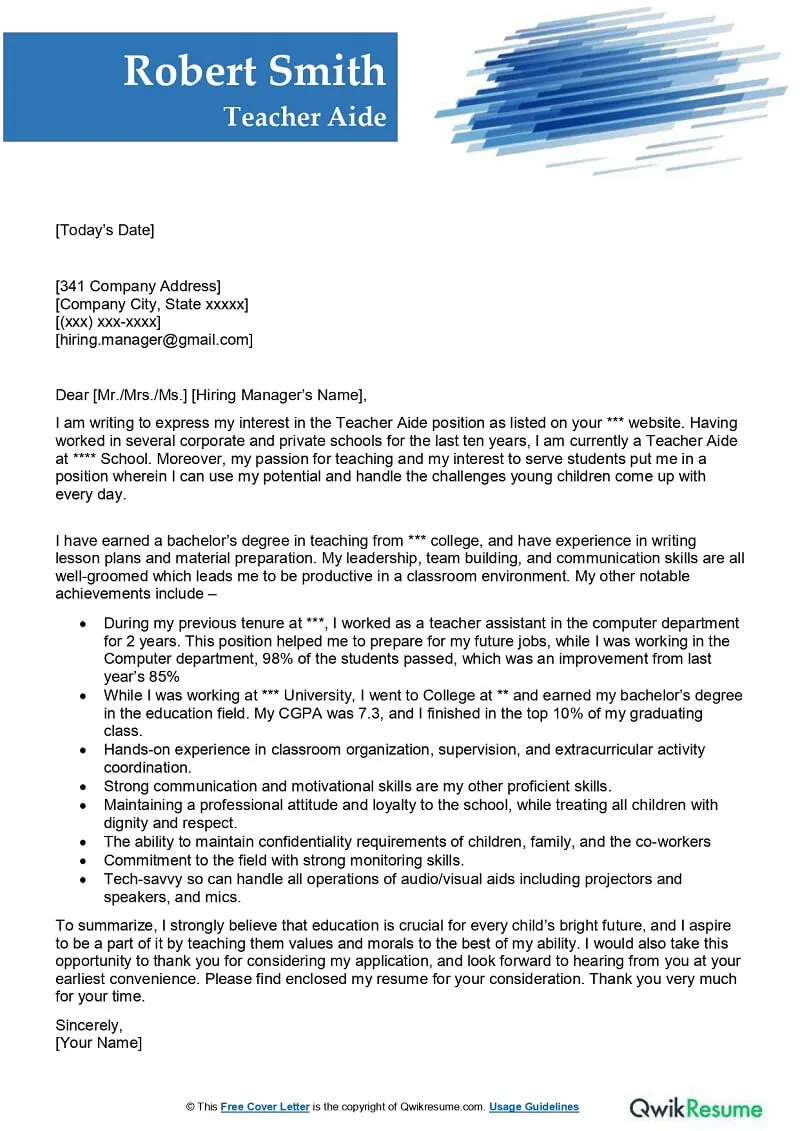
Reviewing cover letter examples can give you valuable insights into how to structure and write your own. Search online for Teacher Aide cover letter examples and analyze how other candidates have presented their skills and experiences. Pay attention to the language they use, the format of their letters, and the way they tailor their letters to specific job descriptions. Don’t copy the examples, but use them as a guide to help you craft your own unique and compelling cover letter. Adapt the examples to fit your own background and qualifications. Analyzing different examples can help you understand what makes a cover letter effective and increase your chances of getting an interview. Remember to always personalize your cover letter, as it’s the most important part of showcasing your unique abilities.
